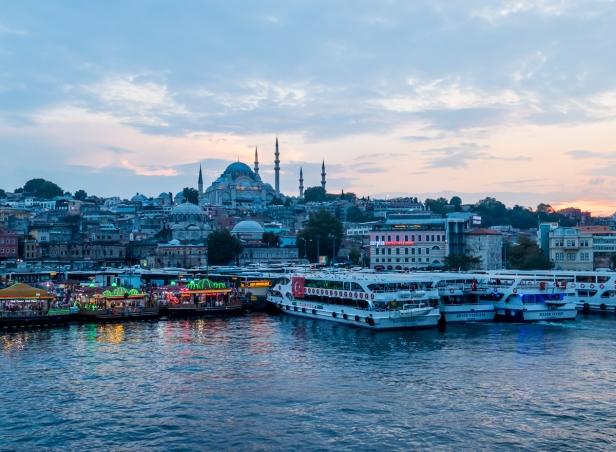
21-29 September 2015. We go full circle in Turkey – from Istanbul to Ephesus, to the Mediterranean coast, to Pamukkale and Konya, to Cappadocia, and finally back to Istanbul.
One day we are having lunch in a park near Topkapi Palace. On a bench to our right I notice a conservatively dressed young couple. I watch them for a long time. I can’t hear them, and wouldn’t be able to understand them if I could, but their body language is clear enough for anyone to understand. He is coming on way too strong. She is not having any of it. They are young, probably still teenagers. She is resistant to his persistent advances and keeps turning from him. At one point while she is partially turned from him she pulls her knees up to her chest and hugs them. It’s all too much for her. He takes her hand from time to time, but each time she eventually takes it back. At times they are silent, not looking at each other, but the connection, the tension is evident. Obviously she has agreed to meet him, maybe even clandestinely, or perhaps it is has been arranged by their parents that they are to marry. Either way she is not happy with his advances. It is too much, or she’s decided she doesn’t like him as much as she originally thought. When they get up and leave he tries to take her hand and she firmly pulls it away. It is probably her first time ever agreeing to be with a boy. And then wishing she wasn’t.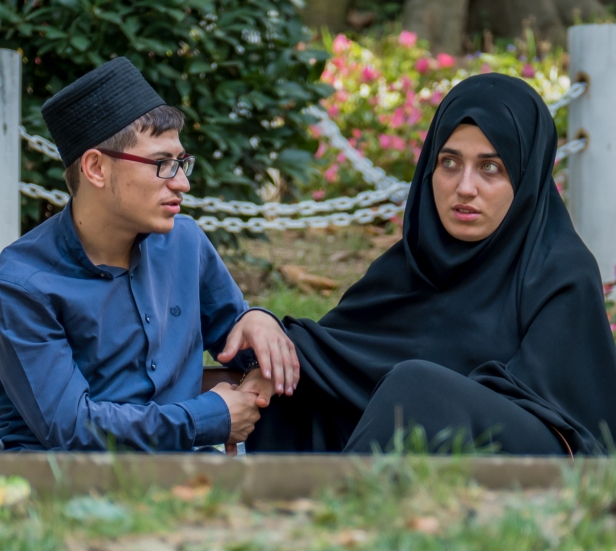
In contrast, the two on the bench to our left obviously love each other and want to be together. They are animated. They are paying attention to each other. Their body language speaks of intimacy, and the joy of being together. The difference between the two couples is remarkable. I felt like I was watching a scene from a play.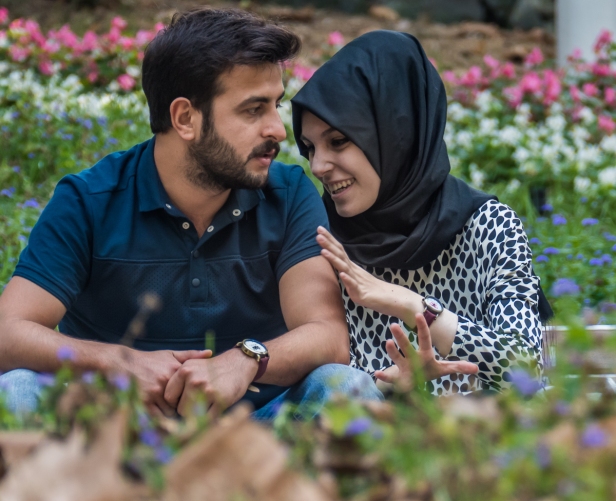
We spend hours and hours exploring Topkapi Palace. I’ve been to several palaces: the Doge’s Palace in Venice, Versailles near Paris, Alhambra in Granada, and the Vatican, among others. Topkapi is surely one of the grandest of all. There is beauty all around me highlighting the extraordinary creativity of the human spirit.
Topkapi was constructed between 1460 and 1478 by Sultan Mehmed the Conqueror, and was expanded by subsequent rulers. It served as the home of the Ottoman sultans and their court until the middle of the 19th century. It’s a massive walled complex containing many buildings which enclose courtyards that were the hub of daily life. Interspersed are trees, gardens and water fountains. At its peak 4000 people lived in this city within a city. There were mosques, huge kitchens, a mint, bakeries, hospitals, schools, libraries, barracks, and secret passageways so royalty wouldn’t have to mix with the hoi polloi. For four hundred years the Ottoman sultans lived in this rarified environment created to protect them and cater to their every whim.
The collections on display there include clothing, fabrics, and sacred coverings, silverware, portraits, glassware, porcelain, jewels, copper, gold plate, arms and weapons, and calligraphic manuscripts.
In the treasury are the jewels of the empire. It is an astonishing collection of objects made from or decorated with gold, silver, rubies, emeralds, jade, pearls and diamonds. The most famous exhibit is the Topkapi Dagger. The dagger was featured in Dassin’s 1963 film Topkapi. It has three massive emeralds on the hilt and a watch set into the pommel. The Kasikçi (Spoonmaker’s) Diamond is a teardrop-shaped 86-carat stone surrounded by dozens of smaller stones. It is the fifth largest diamond in the world, and absolutely breathtaking.
All the items in the treasury, apart from their monetary value, were also thought to have spiritual value. They were originally kept in drawers and were taken out when the sultan came to worship them in a special ceremonial ritual.
Tales abound of lustful sultans, ruthless courtiers, beautiful concubines, and perfidious eunuchs. Popular belief would have it that in the harem the sultan would indulge in debauchery at will. The reality was a little more prosaic. The harem, one of the largest, grandest, and most richly decorated complexes in Topkapi, was the imperial family quarters. The word ‘harem’ means ‘forbidden’ or ‘private’. Every detail of Harem life was governed by custom, responsibility and ritual. There the sultans supported as many as three hundred concubines, four legal wives, and their children.
The valide sultan (the mother of the reigning sultan) ruled the harem. She frequently owned sizeable estates and controlled them through black eunuch servants. Her influence on the sultan, in the choice of his wives and concubines, and on matters of state, was often profound. I can only imagine the power plays, the politics, and the intrigue that abounded in Topkapi during its heyday.
Exploring the palace and grounds there are many highlights and much beauty to be seen. All day I am thinking of the people behind the beauty – those who created the tiles, the carvings, the painted ceilings. It is all such perfect work, intricate and gorgeous. There are several photos showing the decoration in more detail in this post.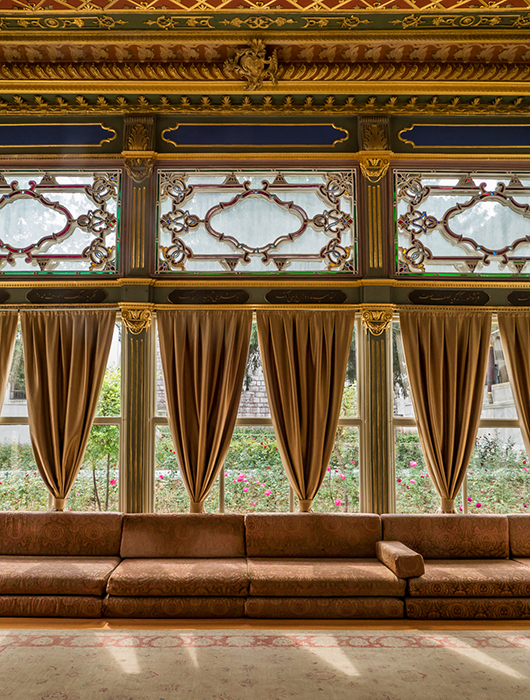
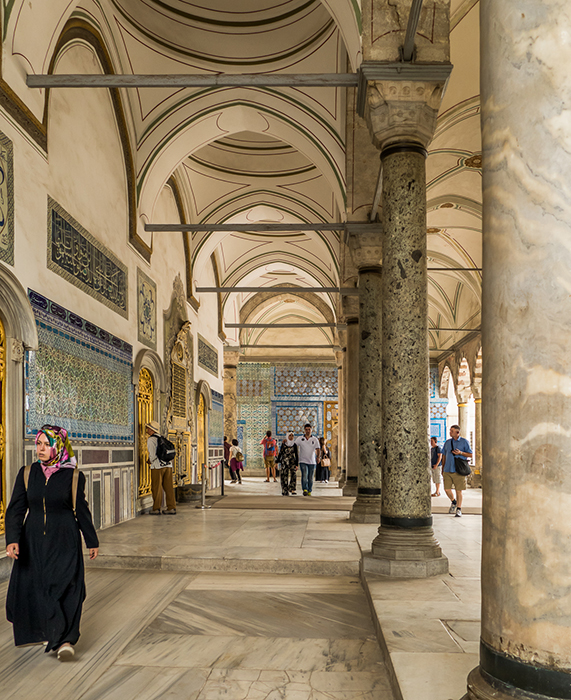


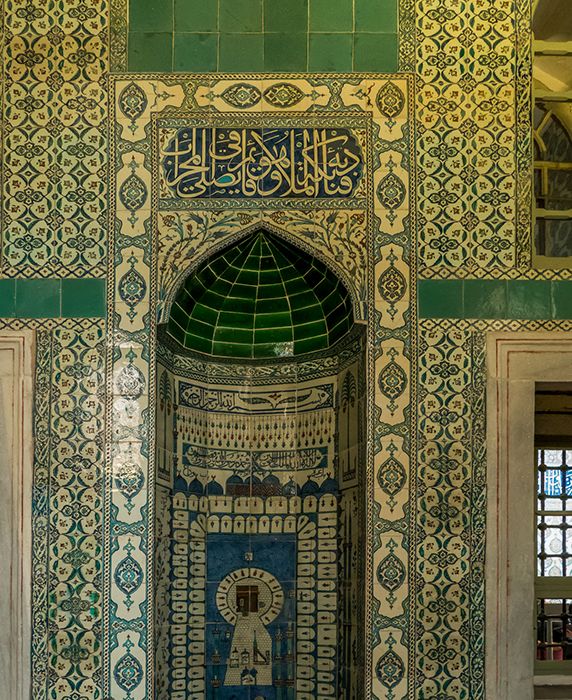
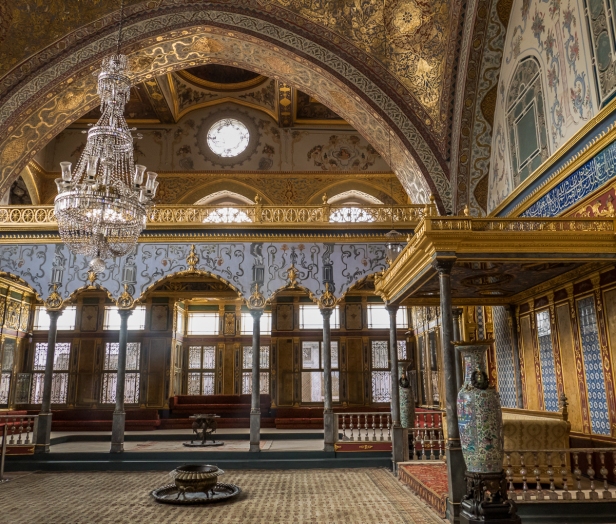
Although surrounded by all this exquisite beauty, best of all for me is being able to touch and turn the pages of an illuminated manuscript of the Koran with its velum pages and delicate detailed design and calligraphy. I first learned about illuminated manuscripts in high school and have always been intrigued by them, wondering about the hours of painstaking focus and patience that must go into making them. What did they do if they made a mistake? Did the scribes ever make a mistake? How did they draw those designs so perfectly? Also most of these books would have been made by candlelight. Human beings are extraordinarily clever. We can even get to the moon and back, but I’m more impressed by the dedication and devotion and artistic aesthetic required to make an illuminated manuscript by hand in the half-light.
I first saw actual illuminated manuscripts under glass in a museum in Sienna. I saw another, under glass, in the Mevlana Museum in Konya. In Topkapi, for the first time, I actually get to see one naked, to touch it, to turn the pages. I am spellbound by its beauty.
Turkey has been a secular state since it was founded in 1923. Over 95% of the population is Muslim however headscarves are banned in the public arena such as law courts, public schools and the civil service. Headscarves are also prohibited in official photographs. The issue has been hotly debated for decades. Currently about 50% of women wear headscarves (tesettür) and a long cover-all coat to meet the Islamic code of modesty.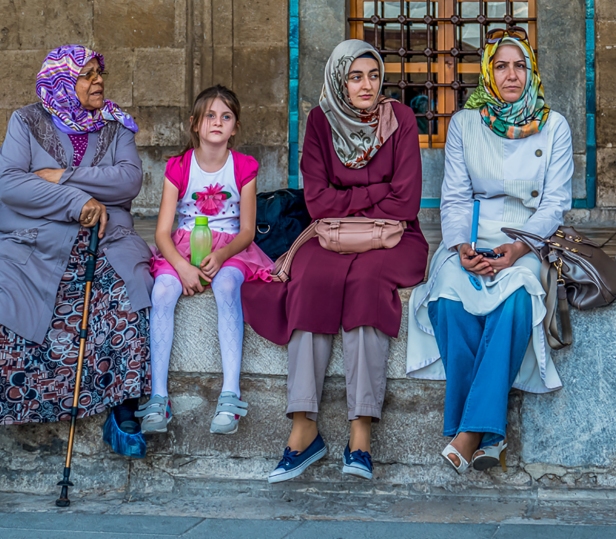
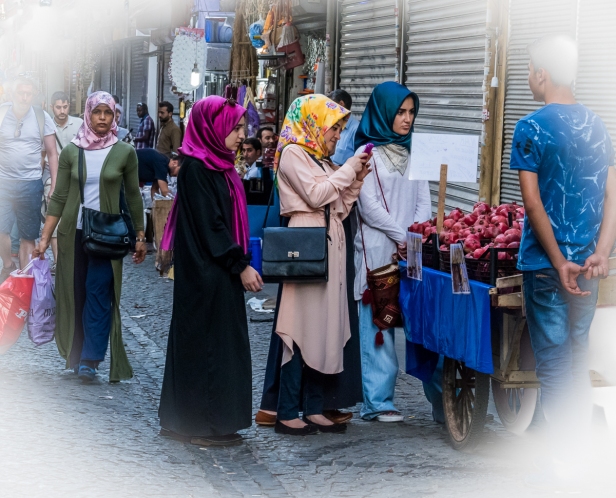
Many Turkish women dress in regular European clothing, but it was the range that caught my attention. Turkish women are to be seen dressed in everything from short shorts and a tank top to full burka with even the eyes hidden behind mesh – and everything in between. Four young women walk by in a group. They are maybe in their late teens or early twenties. Two have tight jeans, short-sleeved tops and bare heads. The other two have tight jeans, long-sleeved knee-length tops, and headscarves. I wonder if they are married and that is the reason they are more covered.
Turkish women can be seen in a “little black dress”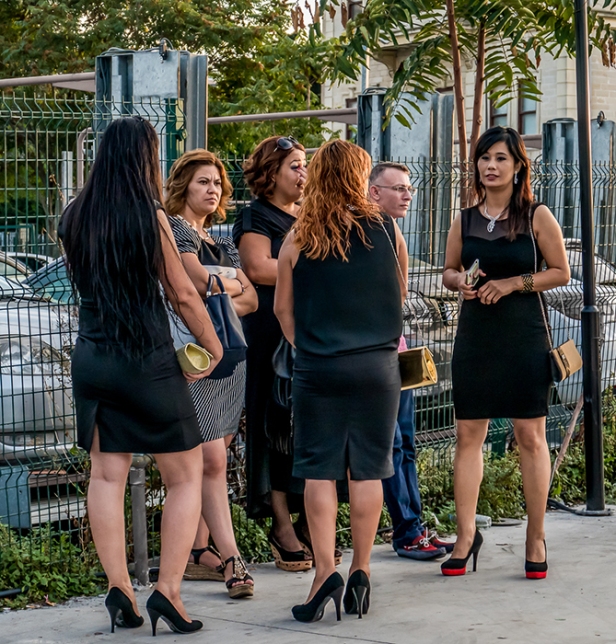
or a very big black dress,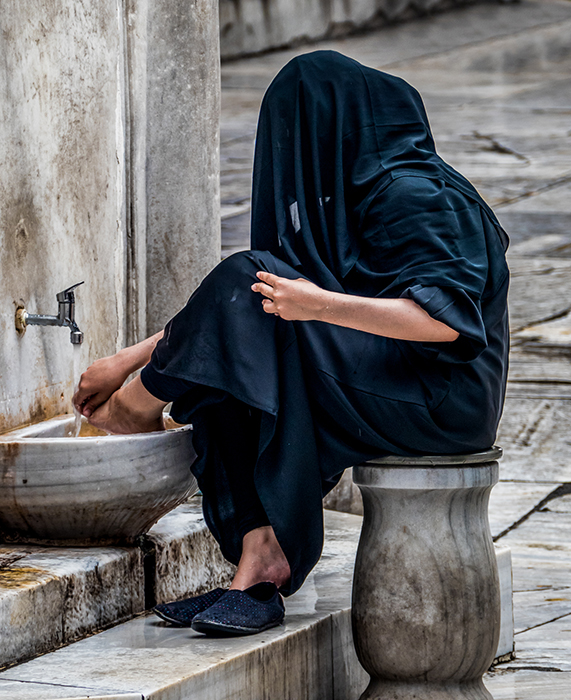
although these women are almost certainly tourists from Saudi Arabia: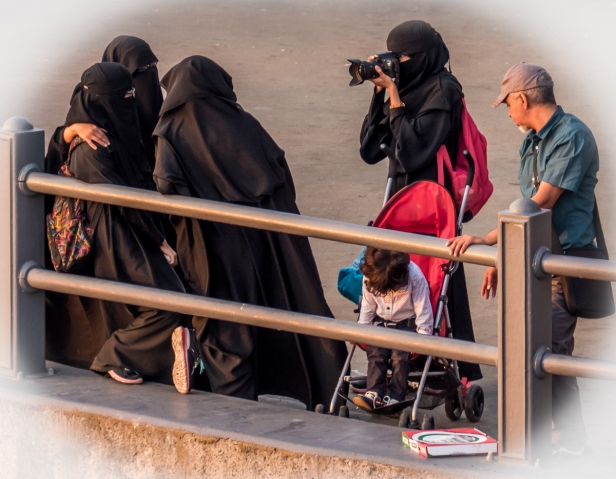

The other things that catch my attention are the way trendy young women have turned the headscarf into a fashion statement,


and that even brides wear a richly decorated version of the tesettür. It’s likely that her groom has never seen her hair.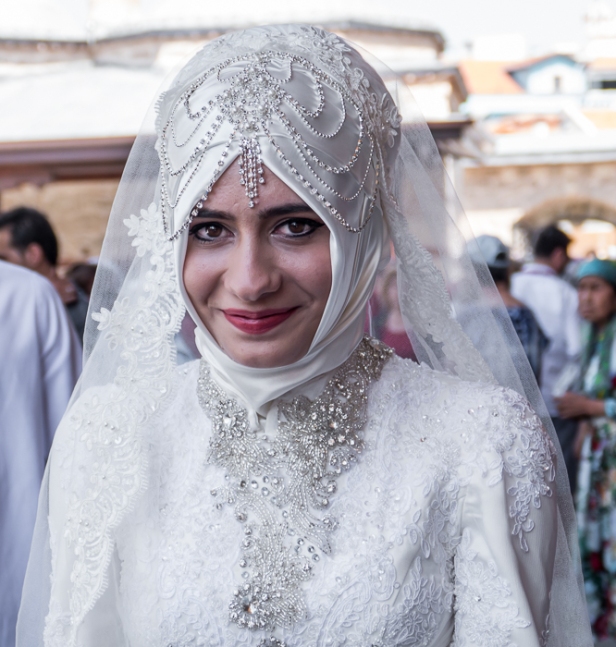
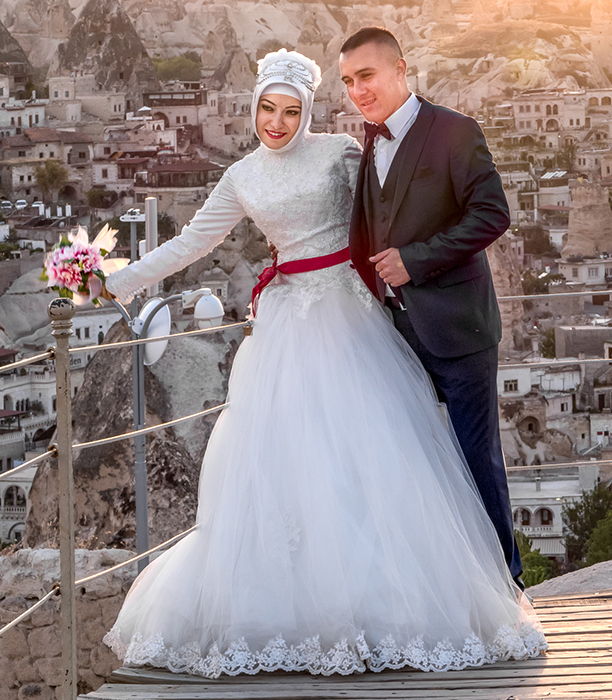
Girls pre-puberty have no such societal constraints,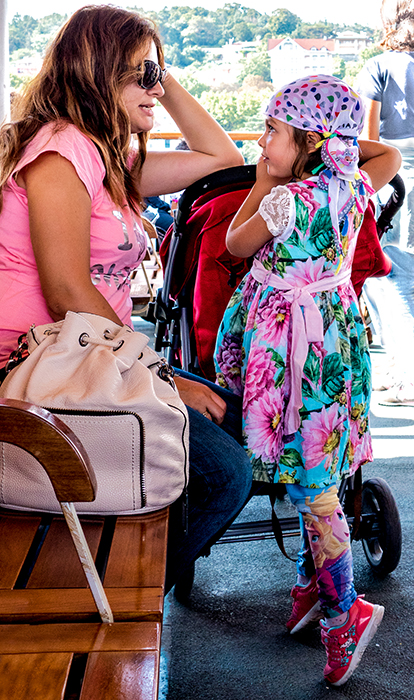
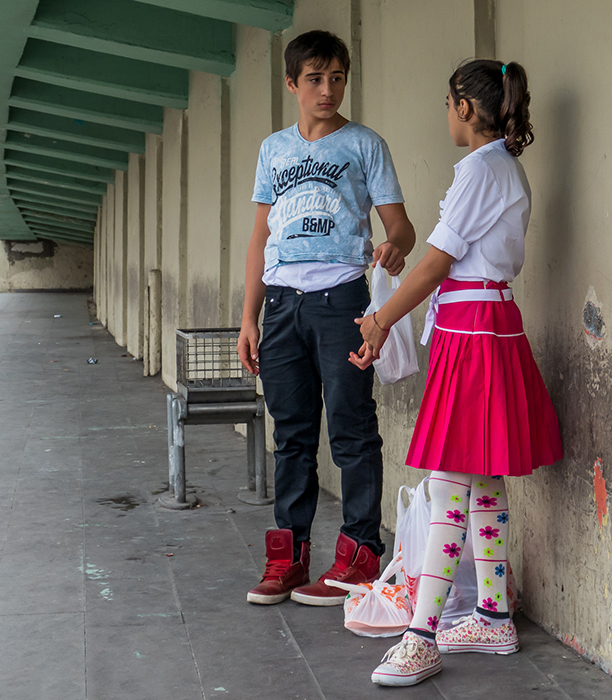
but strict Muslim women, even at the beach, where almost everyone is wearing just about nothing, are covered from head to toe.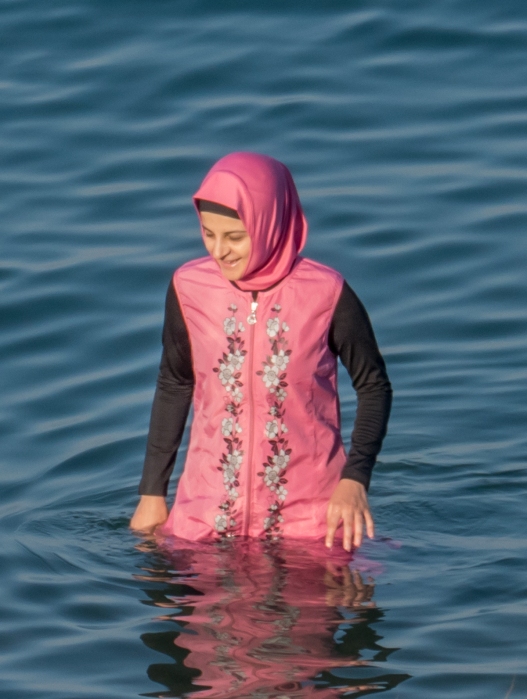
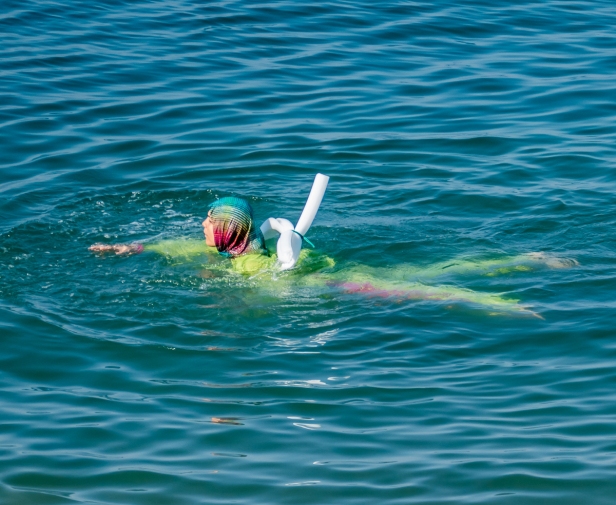
And then there are those who defy categorization.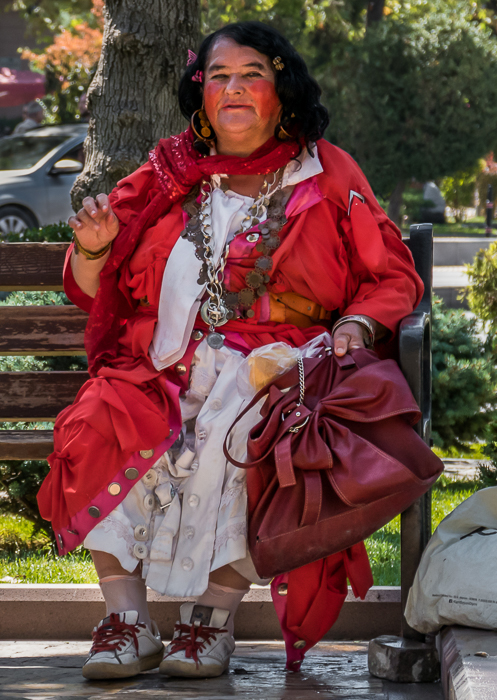
And women who live in the country, like rural woman everywhere, are more plainly dressed.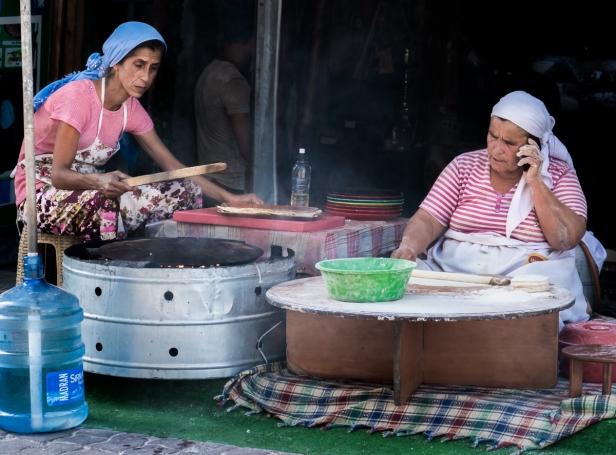
Suleymaniye Mosque sits atop one of Istanbul’s seven hills, dominating the skyline. It is an unmistakable iconic landmark for the entire city.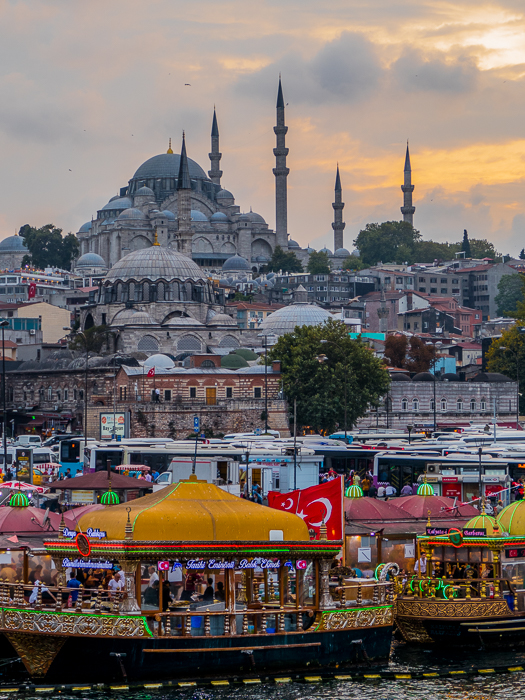
Commissioned by Suleiman the Magnificent, it was built by 3,500 craftsmen between 1550 and 1557. Although it is not the biggest of the Ottoman mosques, I am still impressed by its size and splendor. It is 59 metres (194ft) long, 58 metres (190ft) wide and the main dome is 53 metres (174ft) high. It’s huge! The interior is one of golden spaciousness and soaring beauty.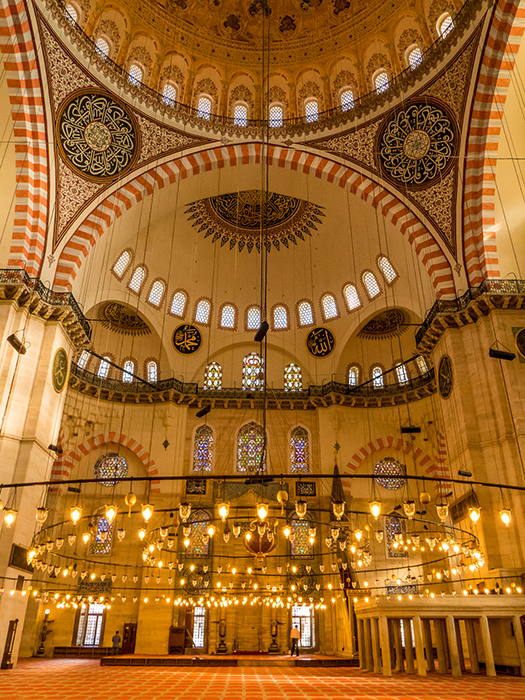
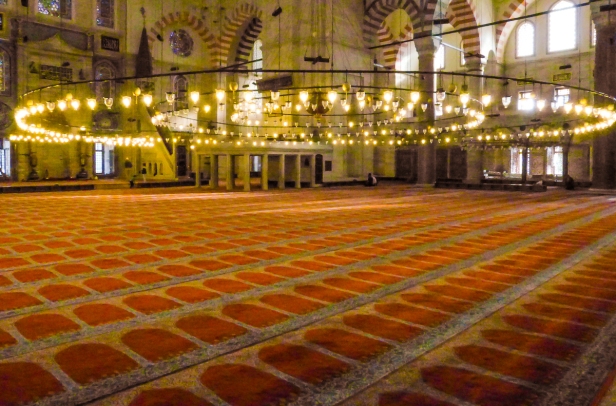
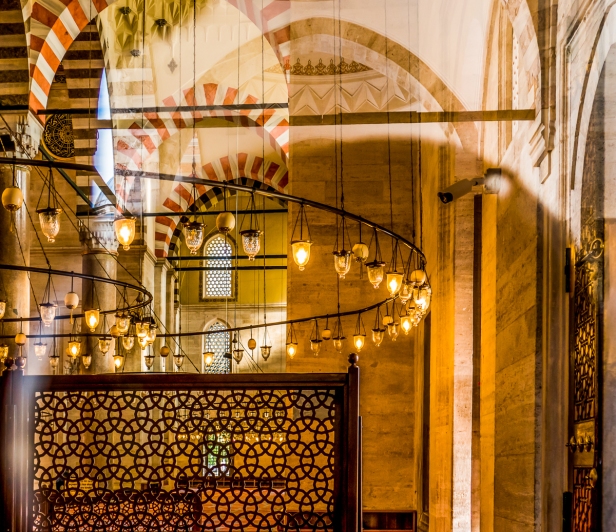
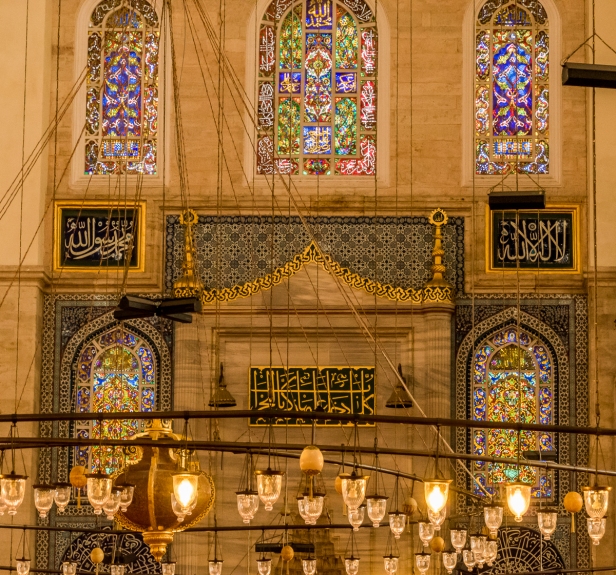
At night we go to the Hodja Pasha Cultural Centre for a performance of traditional Turkish dance. It is held in a five hundred and fifty year old converted Turkish bathhouse. The performance is completely engaging, professional, beautifully costumed, fast-paced, and exciting. We enjoy every minute of it.
There is an incredible female belly dancer. I’ve never seen a professional belly dancer before. Her ability to control different parts of her body, and perfectly in time to the music, is breathtaking. I’m captivated. I didn’t know belly dancing could look like this, every quick or slow movement of the hips, feet and arms perfectly timed to the drums. The rhythm changes from time to time and the dance is obviously meticulously choreographed to follow it.
Later there comes a male belly dancer! I didn’t know there was any such thing, and my introduction is to see one of the best. Like the woman his dance is intricately choreographed and he dances as if he has control of every single separate muscle in his well-toned body. There is also a troupe of about six men and five women who are all superb. They show many different styles of traditional regional dances. No photos are allowed but I include some photos from the brochure to give an idea of the performance.

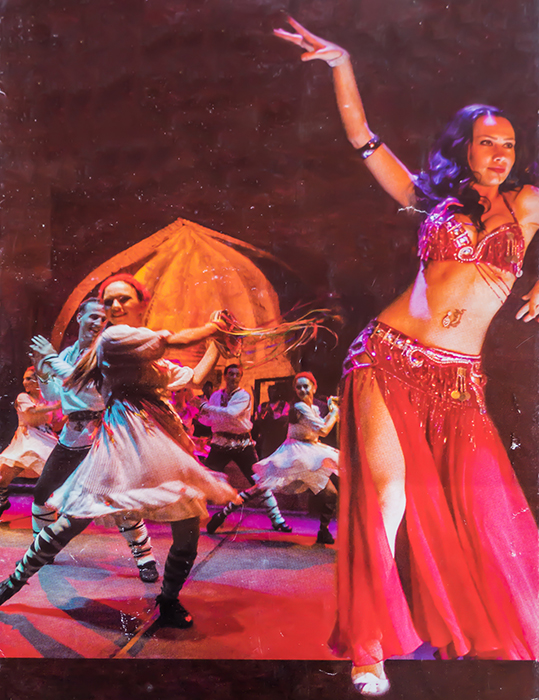
Next couple of posts: A cattle-slaughtering annual holiday, the aromatic spice market, the Grand Bazaar, the waterfront, nargile pipes, Chora Church, Agia Sofia, and more. Istanbul is full of treasures.
Hodja Pasha Cultural Centre
Belly dancer at Hodja Pasha video
Male belly dancer at Hodja Pasha video
All words and images by Alison Louise Armstrong unless otherwise noted
© Alison Louise Armstrong and Adventures in Wonderland – a pilgrimage of the heart, 2010-2016.

👌👌👌
LikeLiked by 1 person
Thank you. 🙂
Alison
LikeLiked by 1 person
Lovely colour – I enjoyed the headscarves – loved your brides. I think we could adopt some of this – I have never really liked brides in strapless dresses
LikeLiked by 2 people
Thanks Helen. I loved the colours of the scarves. Yes, the brides! I was so delighted when I saw them, and surprised by their head coverings. I had not expected that. And I agree totally about strapless dresses.
Alison
LikeLiked by 1 person
Topkapi Palace is magnificent and I loved seeing it with with furnishings to try and imagine living a life in all that “rarified” splendor! The intricate details that go into making all this beauty are amazing and like you I’ve often wondered about the people who create these works of art, crouched over in dim light for hours at a time and days on end. A lovely post and the palace is another “must see” for our list! Anita
LikeLiked by 1 person
Thanks Anita. Topkapi is a very special place and definitely worth visiting. Amazing to think of people living there in all that splendour – I can hardly imagine it. It is one of those “must see” places for sure.
Alison
LikeLike
A thoroughly captivating post Alison. Thank you. You did a wonderful job showing us the women’s attire. The lady in the red dress???
LikeLiked by 1 person
Thanks so much, I’m glad you enjoyed it. I was frequently surprised by the way women dress – so much variety from blatantly sexy to fully tented. It was such an interesting mix. And yeah, the lady in the red dress! That really astonished me. I wish I could have talked to her and found out a little of her story.
Alison
LikeLike
always wonderful to see the fashion of our world ☺️ lively post Alison again! Happy weekend to you 😀
LikeLiked by 1 person
Thanks Hedy. I’m no fashionista that’s for sure, but I’m always intrigued by what people wear, mostly women, because most men, the world over it seems wear jeans and a t-shirt. Women bring the colour! Unless of course they need to be black-tented.
Alison
LikeLike
I like the picture of the woman making Gözleme…
…it has been a long time since I ate any 🙂
LikeLiked by 1 person
Thanks rabirius. And thanks for letting me know what they are making. I’m sure I ate it many times in Turkey but didn’t know what it was called. Yummy.
Alison
LikeLike
Great post Alison. I especially love all the photos of the women and their attire…so interesting! You did a great job capturing the two couples and I suspect your assumptions based on body language are correct.
LikeLiked by 1 person
Thanks Caroline. I was quite fascinated with the very wide range of clothing the women wore, though it was mostly regular modern European, but often with the head scarf as well. And watching those two couples, especially the younger couple was pure theatre.
Alison
LikeLike
You never disappoint, Alison. Each blog is a work of art and information. The palace is gorgeous. I was fascinated by the large glasses the women wore, a statement in itself. As for your observations at the beginning, they remind me of Peggy, who is always watching people and making interpretations from the postures they assume. (She prefers to hear what they are saying. :)) I’ve seen some talented belly dancers at Burning Man but I doubt they can match these. Thanks for your insights, as always. –Curt
LikeLiked by 1 person
Thank you so much Curt! Topkapi is spectacular, a little hard to believe it is so extravagant. Oh yes, those glasses are definitely a fashion statement. Very cool. And watching the young couple especially was wonderful theatre. It was quite clear what was going on. She was terribly innocent and shy. The belly dancing was unbelievably fabulous. I’ve seen lots of belly dancing by women who take it up later in life as a kind of hobby for exercise. I discovered that it is very little like the real thing.
Alison
LikeLike
There is, or at least was, a camp at Burning Man that taught belly dancing. The muscle control is amazing. –Curt
LikeLiked by 1 person
Yes it is.
LikeLiked by 1 person
The pictures are amazing! I absolutely loved the tiles, we have a big tradition in Portugal we got from the Mourish when they invaded. And the veils can be so colourful and stunning. There are a lot of muslims in London and I love it when they get creative with them.
A wonderful post 🙂
LikeLiked by 1 person
Thank you so much. I love the Islamic tiles. I think I first saw them in the Metropolitan Museum of Art in New York. I was in raptures over their beauty. And here I finally was in an Islamic country to swoon over them some more. We went to the “Tile Mosque” which I’ll include in the next post – more walls of beautiful tiles!
I also love what the women do with their veils – very creative, colourful, and beautiful.
Alison
LikeLiked by 1 person
I enjoyed seeing the full range of women’s attire. The brides are beautiful; I’ve never seen that kind of headwear nor the word you used to name it. I like Ms. Defy Categorization …. and wondering if she’s female or she-male. Whatever; she’s stylin’! Almost red-hat-society with her nearly-purple bag.
LikeLiked by 1 person
Thanks Kate. I was so delighted with the brides. Of course I’d never seen anything like it, and they make the headdresses look so beautiful with all the beads and lace. Ah yes, Miss Defy-Categorization! What a beauty! I do wish I’d been able to talk to her and find out something of her story. For all I know she dresses like that to get money from tourists taking photos of her. I was a distance away with my trusty zoom lens. I loved her whole outfit. What a character.
Alison
LikeLike
Alison, Masha’Allah, absolutely magnificent.
Your posts are a work of love and a provoking insight into the beauty of humanity at large. You should know, each time you post your masterpieces, you send an invaluable gift that stirs the heart and one’s imagination.
Thus, in my mind, you are an ambassador of peace and harmony….like we Canadians like to think of ourselves.
Allah Hafiz in all your pursuits.
mashoud
LikeLiked by 1 person
Thank you so much Mashoud. What lovely compliments you pay me. I’m glad you enjoyed the post. And it’s always nice to connect with a fellow Canadian.
Alison
LikeLike
Masha’Allah, a magnificent piece of work. Your efforts exude an extraordinary love for humanity and its beauty. It seems, your eyes see without malice or preconception and thus exude commonality and harmony that is so painfully absent in the present time due to obfuscating politicians.
Each time you write, you send us a gift and stir the heart strings and indeed, the imagination. Thank you.
In my mind, you are an ambassador for peace and for whatever is good in all cultures.
But then, isn’t it what we Canadians like to think of ourselves?
Allah Hafiz and may you fulfil all that your heart desires.
mashoud.
LikeLiked by 1 person
Thanks again Mashoud. I do love humanity, that’s true. There’s much in the world that we could label evil or bad or “sinful” but I prefer to focus on the good. At heart we all want the same things – apart from food, shelter and water, we simply want to be seen, to be respected, to be loved and to live in peace.
Alison
LikeLike
Impressive. The palace, the photos, the text, the characterisation all set a high standard.
I’m curious though – do you think that as a woman it was easier for you to take pictures of the Muslim women?
LikeLiked by 1 person
Thank you Dave. Istanbul is so full of character and beauty and wonders that it’s sometimes a challenge to distil out the best things to present. The photos always lead the way. When I manage to get interesting photos it makes it easier to put a post together. Sometimes I can get a bit bogged down in research and complain to Don that it feels like I’m writing a school essay. And then every time it all comes together in the end.
I suspect it might be easier for me being a woman photographing Muslim women, but honestly I use a zoom lens, and don’t always ask permission. Obviously some subjects see me taking the photo and may react strongly if a man had taken it.
Alison
LikeLiked by 1 person
I love the photos, as usual. But I was especially intrigued by the one Don took. It looks like a chandelier, but very close to the ground. I studied it a long while and still can’t figure it out. Please describe!
LikeLiked by 1 person
Thanks Kay. You’re right, it is a chandelier. You can get a better sense of the enormous size of the building from the photo that comes before mine: the chandelier is actually 12-14 feet above the carpeted floor in a space that is 174 feet high to the top of the dome! Hope that helps you get a better sense of the breathtaking grandeur of the place. Don <3.
LikeLiked by 1 person
Were you one a balcony or something? The blue things (kneelers?) Look so close from that angle.
LikeLiked by 1 person
No, I was kneeling down on the carpet. I’m not sure which blue things you mean: the stripes in the carpet, perhaps? Don
LikeLike
Thanks Kay. I guess Don’s pretty much explained his photo. The interior space of the mosque is enormous! The photo was taken down very low looking across the carpet – a trick I learned from a fellow traveller in the Galapagos and then passed on to Don.
Ali
LikeLike
beautifully
expressed
humanity 🙂
LikeLiked by 1 person
Thank you
simply
expressed
Alison ❤
LikeLike
Alison you are a great storyteller and your photography is magical. I look forward to each of your blog posts and smile to my self when I see it arriving in my inbox. Does it take you long to write it? I am glad you managed to hold a illuminated manuscript in your hand, sounds like a dream come true for you?
LikeLiked by 1 person
Thank you Gilda! What a wonderful compliment. When people say things like this I’m always both thrilled, and surprised. Thank you.
Looking at that illuminated manuscript, touching it, turning the pages of it, of something so very beautiful, and hundreds of years old – it was a moment to be treasured that’s for sure. It’s one thing to see a picture, but finally seeing the real thing (without it being under glass) was very special.
Each post takes several days (on and off) of choosing and editing photos. Next step is research when I go on the net and make notes of the places I want to write about. I have a short attention span for this kind of thing (its a bit too much like being back in school) so this takes a few hours on and off during one day. Then when I have notes from my journal, photos, and background information all gathered I start writing and that usually takes most of two full days.
Alison
LikeLike
Beautiful! Those women with glasses on their burkas are a hoot!
The male belly dancer that you linked to–his style was very feminine. Was the male belly dancer you saw similar? I guess I expected there would be a masculine form of belly dancing, but the guy in the video’s moves didn’t, to me, feel like masculine sensuality. I’m not sure what masculine belly dancing would look like! Maybe more aggressive? I’m really curious about this. Do you know if it’s traditional or just a modern thing to have men belly dance.
LikeLiked by 1 person
Thanks Jane. I think I didn’t even notice the glasses until I later looked on the computer at what I’d captured. I often take photos of people using the zoom lens so I’m never quite sure what I’ll get.
Here’s an interesting article about male belly dancers
http://www.smithsonianmag.com/arts-culture/inside-world-istanbuls-male-belly-dancers-180953539/?no-ist
And a video of a different male dancer – just as feminine. Not surprising since they copied female belly dancers.
Alison
LikeLike
Good article. He nailed it at the end, referring to the ‘gender confusion,’ which I kind of felt when I watched it. Not because it was a man dancing like a woman, but because I couldn’t figure out what my own response to it was. Did I find it alluring? And if I did, was it alluring because it was feminine or because it was a man? I was surprised to learn it is an old tradition. I think perhaps in the past, the gender and sexuality lines weren’t as well-defined as they are today (even though social roles were)– and I believe we’re headed back in that direction again as it becomes more acceptable to express one’s own gender fluidity.
LikeLiked by 1 person
I so enjoyed this walk through the couples and the women and their outfits. I think I might also see a little budding attraction in that pre-adolescent scene! Of all the gorgeous photos of tiles and dresses, woodwork and veils, the picture that I find most beautiful shows the layers of the boats in the Golden Horn, the markets, the Suleymaniye Mosque, and behind it all, that luminous sunset. To me that epitomizes Istanbul and its rich jumble of colors and textures, sun and shadow.
LikeLiked by 1 person
Thanks lexklein. I think I must agree with you – the opening photo right? I love that photo. It is such and iconic image of Istanbul. I was on Galata Bridge of course.
Alison
LikeLiked by 1 person
All just lovely photos again. I have to admit, the Topkapi overwhelmed me. I don’t think I appreciated it as much as I might have. Just too much stuff to look at, maybe? I agree with Lex…love that photo of the Blue Mosque and all the hustle. The second male dancer you posted in comments is…freaky outrageous. And of course, they look feminine, it’s only a female “thing” traditionally.
LikeLiked by 1 person
Thanks BF. I was a bit overwhelmed with Topkapi too – one room after another where my jaw dropped to the floor and I’m squealing over the beauty. Sooooo much to take in. I love that male dancer – his arms are like liquid. Beautiful. The first link I posted is of the dancer we saw at Hodja Pasha, though not the same dance I think. It was amazing to see it live.
Alison
LikeLiked by 1 person
what is it they say about too much of a good thing? And right…that guy, the second one in your comments section, moved better than ANY female dancer I’ve seen…
LikeLiked by 1 person
Alison,
I know that you go to great lengths to comprehend your visuals but, I am wondering if you deciphered what is written in Arabic Calligraphy , especially some verses that are dominant ?
Would you like to know?
mashoud.
LikeLiked by 1 person
I have no ability to read Arabic at all. In this post:
there’s a photo of a page from Rumi’s prayers. Perhaps you could translate a little bit of that. That would be lovely.
Alison
LikeLike
Your pictures and stories capture the essence of Turkey. The bride is so lovely. Thanks for taking me along!!
LikeLiked by 1 person
Thank you so much Darlene. I loved seeing the brides – so beautiful. I think I saw three in all. Apart from the headdresses, which of course really stood out for me, I noticed that they all had something red on their dress. The one above has a trailing red ribbon around the waist. All the others had something similar. I never did find out the significance of it.
Alison
LikeLike
Perhaps it is similar to our custom of wearing something blue, instead they wear something red. It would be interesting to find out.
LikeLiked by 1 person
Apparently it’s a symbol of maidenhood. Apparently, as in many society’s throughout history and throughout the world, it used to be the tradition to inspect the sheets for blood the next morning. I am saying nothing of my bewilderment and fury over this double standard . . . . . . .
LikeLike
Oh my! Thanks for letting me know. I’ll stick with something blue.
LikeLiked by 1 person
Wonderful photos of the different Turkish fashion. It is interesting to see the variance among different Muslim countries and regions. I don’t remember seeing that many Turkish women in shorts and dresses, but it was cold and rainy when we were there. As you say, most of them make them into fashion accessories. They often match their shoes and belt and purse.
Those top two photos are classic. People watching is strangely fun.
LikeLiked by 1 person
Thanks Jeff. We were on the Mediterranean coast in August, and there were plenty of Turkish women, along with the tourists, in shorts/summer dresses/swimsuits, though for sure I didn’t see any in the city. I love what they do with the head scarves. I don’t love that they feel compelled to wear them. Have trouble with the double standard for men and women.
Love people watching – at it’s best it can be like watching a movie. And this was a good example of that.
Alison
LikeLike
Awesome picture.. wonderful…
LikeLiked by 1 person
Thank you so much Nisha.
Alison
LikeLike
Amazing and the male belly dancer was so unique, a male in a female dance routine. Again your photos take me into a magic world I have not had the opportunity to visit.Thank you for sharing in such depth.
LikeLiked by 1 person
Thanks pommepal, it’s my pleasure. I love sharing.
I was amazed by the male belly dancer. I never knew such a thing existed, and I loved it. It was a wonderful thing to see live. I have a passion for dance. We go to traditional dance performances in just about every country we go to.
Alison
LikeLike
I agree with you about dancing especially traditional dancing in the country of origin
LikeLiked by 1 person
What an amazing assortment of photos Alison! I especially love the bride, the girls swimming fully covered and the girls in black getting their photos taken. Beautiful. 🙂
LikeLiked by 1 person
Thanks Nicole. I *loved* the bride! I’m so glad she let me photograph her. Well she and groom were out on a photoshoot so I just joined in – on both occasions. There was also a third bride but she didn’t have the Muslim headdress, which I’d never seen before and which is so beautiful and distinctive.
Same for the girls swimming! I’d certainly never seen that before – I was fascinated.
And the women having their photo taken – how will they know who’s who? I thought it was a lovely moment. I recently read a wonderful in-depth NatGeo article about Saudi women – they tell each other apart by shoes and hand bags.
Alison
LikeLiked by 1 person
I sometimes see Somali girls and women fully covered swimming here in Minnesota. I have also seen a regular runner fully dressed in the high heat of our summer, out running all in black. She looks happy! I loved this post
LikeLiked by 1 person
Love the ‘other’ beauties! Every single one 🙂 It is disappointing though that the country has veered away from Ataturk’s secular legacy. I have always wished we had someone as strong as him to steer our nation away from religion, but I guess we would have been back where are in no time as well. Religion is a powerful tool and only the most enlightened will refrain from using it to control people.
LikeLiked by 1 person
Thanks Madhu. And yes I must agree. I too am disappointed. I applauded Ataturk’s secularism, and have aways been appalled by the abuse of power, particularly patriarchal power, by all religions.
LikeLike
Alison, as usual your people shots are outstanding – how do you get the focus just right with everything else blurred just so? The first bride with her bejewelled tesettür is a clear favourite. She is just radiant, and her expression is one of quiet contentment. As for the Islamic code of modesty, I too am jarred by the double standard… the photo of tourists from Saudi Arabia taking pictures at the railing strikes me as very poignant. It doesn’t seem like the right shot for any family album.
I share your fascination with illuminated manuscripts – there was a time when I was obsessed with the Book of Kells so one of my notebooks is embossed with a design from one of its pages. I have never been able to understand how their creators avoided making mistakes.
And I can’t get my head around one of your photos from Suleymaniye Mosque (the one under Don’s shot). The colour and lighting are sublime, but I feel like my eyes are playing tricks on me. It looks like an optical illusion, as though two pictures were perfectly merged into one. How did you manage that?
LikeLike
Thank you so much James. I was thrilled to get that shot of the bride. She was smiling at the professional photographer taking photos for the couple, and saw me, so smiled for me also. It was a lovely moment. I get the blurred background by being at a distance, and zooming in with a very low F-stop which of course shortens the depth of field to almost nothing. You can also get the same effect by shooting manual and deciding which part of the frame you want in focus. I almost only ever shoot manual for stationary subjects because I’m very slow at focusing.
I think you really hit the nail on the head with your comment about the Saudi women being photographed by their friend – how sad that they can look at that photo and know each other only by their bags and shoes, and, hopefully, maybe, by their eyes. I find the whole double standard incomprehensible.
I too have never been able to understand how the makers of illuminated manuscripts could do so without making mistakes – I think it’s part of the appeal for me. I’ve done some detailed art work over the years and remember times of throwing my brushes down in frustration because I’d made yet another mistake!
That photo of Suleimaniye was taken from the outside and is in fact a composite showing something of the inside and also showing what was reflected in the window. I can’t get my head around it either – I can’t figure out what’s what, but I like the composition and feel of it.
Alison
LikeLiked by 1 person
Wow – thank you for the tips, Alison. I should really start experimenting with the F-stop… my camera is usually set to aperture mode but I rarely mess around with all the different buttons and dials!
I do love that shot from Suleimaniye – it is so creative and sublime. And the mystical mood pretty much jumps through the screen. Now that you’ve told me it’s a reflection, it makes total sense. 🙂
LikeLiked by 1 person
What a fantastic post! Topkapi was also one of my highlights in Istanbul. Thank you for your lovely profile on Turkish female style. “Range” is definitely the word that comes to mind. Izmir, where I am currently living, is the third largest city in Turkey and I love the fashion parade I see on a daily basis, from conservative dress to very stylish and European-influenced.
LikeLiked by 1 person
Thanks Mo. Topkapi is quite amazing isn’t it?! I was quite fascinated by the range of clothing, and I’d imagine it’s the same in Izmir as elsewhere, except Konya, which is noticeable more conservative. I especially loved the bride dresses – I’d never seen anything like that.
Alison
LikeLike
iconic Istanbul really great grand bazaar what a experienced. i will see all peoples and all are amazing what a dress up and all this credit goes to fashion designer of Istanbul and amazing whether.great experience in Istanbul had a great journey.
Istanbul rocks guys
LikeLiked by 1 person
Thank you Jack. The Grand Bazaar was a really wonderful experience, and I loved seeing all the different fashions. I agree – Istanbul rocks!
Alison
LikeLike
Great post and photos! I LOVE Istanbul. Topkapi Palace is fascinating too!
LikeLiked by 1 person
Thanks for sharing those beautiful photos, and your post is captivating, I have visited Istanbul and its islands, I wished I could had more time to go to other places out there, it’s never enough to enjoy this country, hope this pandemic covid will disappear soon, and the whole world will be leaving in peace and conviviality.
Kalimelo
LikeLiked by 1 person
Thank you so much Kalimelo. We loved Istanbul – so much to see and do there, such an intriguing city.
I too hope the pandemic will be over soon. Stay safe and well.
Alison
LikeLiked by 1 person